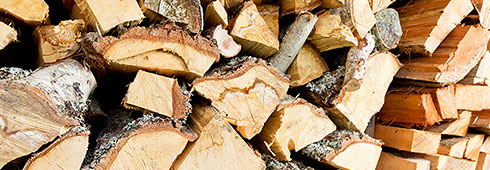Chopping wood, DIY, according to Stihl.
How to Select, Split, Stack and Store Firewood

For wood-burning fireplace and stove owners, splitting and stacking wood is an important skill to know. Whether it’s your first time stacking a woodpile or you just want a refresher course on proper splitting technique, we've got a number of helpful tips on the best way to stock winter wood.
Are You Cutting Wood From a Fallen Tree?
If you’re starting your wood pile right from the source – a fallen tree – there are a few things to keep in mind when doing the initial cutting. First, the timing: cut your firewood at least six months ahead of when you plan on burning it. The ideal time to cut firewood is in the late winter and early spring months. This allows for the maximum drying time.
Next, cut the ends of the logs as flat and square as possible so that they can stand sturdily for splitting. For this, we recommend the STIHL Pro Splitting Axe or STIHL Pro Splitting Maul. If the wood has branches, cut toward the opposite direction they are pointing. Remember, the shorter the log, the easier it will split. Look for hairline cracks on the log and direct the swing of your axe to strike these cracks. This will reduce the splitting effort. Try to avoid cutting through knots – knots and branches change the direction of the wood grain in the log and make splitting more difficult. Try to align the strike of the axe so it does not split through the knot.
Wood Burning Safety
Burning firewood creates many byproducts, including smoke, water vapor, various gases, hydrocarbons and tar. Over time, these materials can accumulate in your fireplace and increase your risk of danger, including chimney fire and carbon monoxide poisoning. Always keep your fireplace chimney well ventilated and have it cleaned. The U.S. Consumer Product Safety Commission, the U.S. Environmental Protection Agency, the National Fire Protection Association, and the American Lung Association recommend annual maintenance and inspection of your home’s heating systems, fireplaces included.
Wood Selecting

Purchasing Firewood
Buying firewood is a convenient option for those who enjoy wood fires but don’t have the time or means to cut and season their own. Buying the right wood in the right amount, however, does require some research. Wood vendors sell all year, but tend to charge more during the colder months due to higher demand. Plan ahead and buy in the late spring and summer months. Ask if the wood is “ready to burn” and has been properly seasoned. Fresh wood requires at least 6 months of seasoning time before it is dry enough for optimal burning.

Wood Amounts
Firewood is typically sold by the cord. A cord of firewood, when stacked, will measure around 128 cubic feet (8’ long x 4’ high x 4’ deep). This includes wood, bark and the space between wood pieces. Depending on the type of wood and how it is stacked, the actual cubic feet of wood found in a cord can vary significantly. If that is more wood than you need, you can buy a “face cord” or “rick” of wood instead. A face cord is approximately a third of a cord, measuring 8’ long x 4’ high and is as deep as the individual logs.

Wood Types
Get more burn for your buck by selecting the right kind of wood for your fire. Softwoods, such as pine, fir, spruce and redwood will burn quickly and you might find yourself filling the wood rack more often. Hard woods such as oak, eucalyptus, beech and birch will burn longer and “cleaner,” leaving less creosote residue behind. NOTE: Trees with gnarled, knotted grains, such as hickory and elm are more difficult to split.